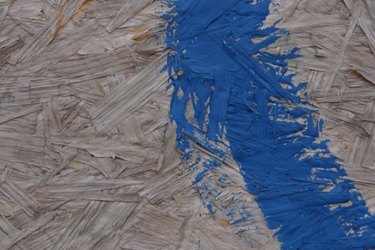
Canvas is the most frequently used material for oil and acrylic paintings. It is a textile, woven material that is also extremely sturdy. The canvas is stretched on a wooden frame and stapled to the sides of the frame. Mixed-media artists often experiment with the surfaces they paint on and substitute canvas with wooden boards, cardboard, glass or metals. Painting on various surfaces is possible as long as you prime them properly.
Cardboard
Video of the Day
Cardboard is a cheaper substitute for canvas in painting and it is also a great way to recycle. Just like cotton or linen canvas, the cardboard should be treated with gesso, which is a primer that contains chalk or gypsum and glue. Gesso strengthens the cardboard and also makes it less absorbent, preventing the paints from soaking into the surface of the cardboard. Cardboard is easier to store and transport than wooden panels or paintings on canvas. Thinner sheets can be rolled. However, if you use thick layers of paint, rolling the cardboard may destroy your painting.
Video of the Day
Wooden Panels
Wooden panels were used by great masters of painting, including Albrecht Dürer and Leonardo Da Vinci, up until the 17th century, when the panels were replaced by stretched canvas. Various types of wood may be used as panels for painting: oak, poplar or pine. Prime the wooden panels prior to painting on them, because wood is a highly absorbent material and the colors may not adhere properly without proper priming. Sand the panels and prepare them with gesso or diluted rabbit skin glue. Great masters of painting used to apply up to 15 layers of gesso on the panels. The main disadvantage of wooden panels is the fact that the paintings will be heavy and difficult to transport, especially when you make oversized paintings. Canvas can be removed from the frame or stretcher when transported; wooden panels cannot.
Glass
Religious icons are often painted on wooden panels or glass surfaces. Painting on glass is possible, despite the fact that the material is slippery. If the surface is primed, you may use regular tempera or oil colors, but you also have the option of buying special glass painting colors that adhere to glass.
Metal
Painting on metal sheets (e.g., aluminum, steel and copper ) is not as popular as canvas painting, but it is a technique that can be explored. Prior to painting, sand and clean the surface thoroughly. Oil paints adhere to metals without the need for primers and will also prevent rusting. However, if you are using other types of colors, prepare your surface with an oil-based primer or pigmented shellac. Cover your painting with a coat of epoxy or varnish to protect the colors and prevent flaking.